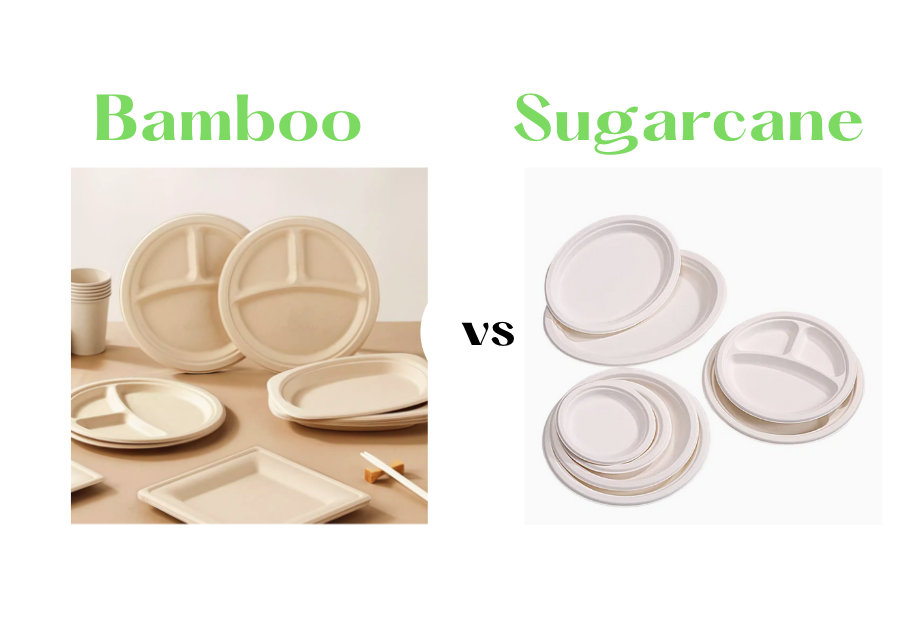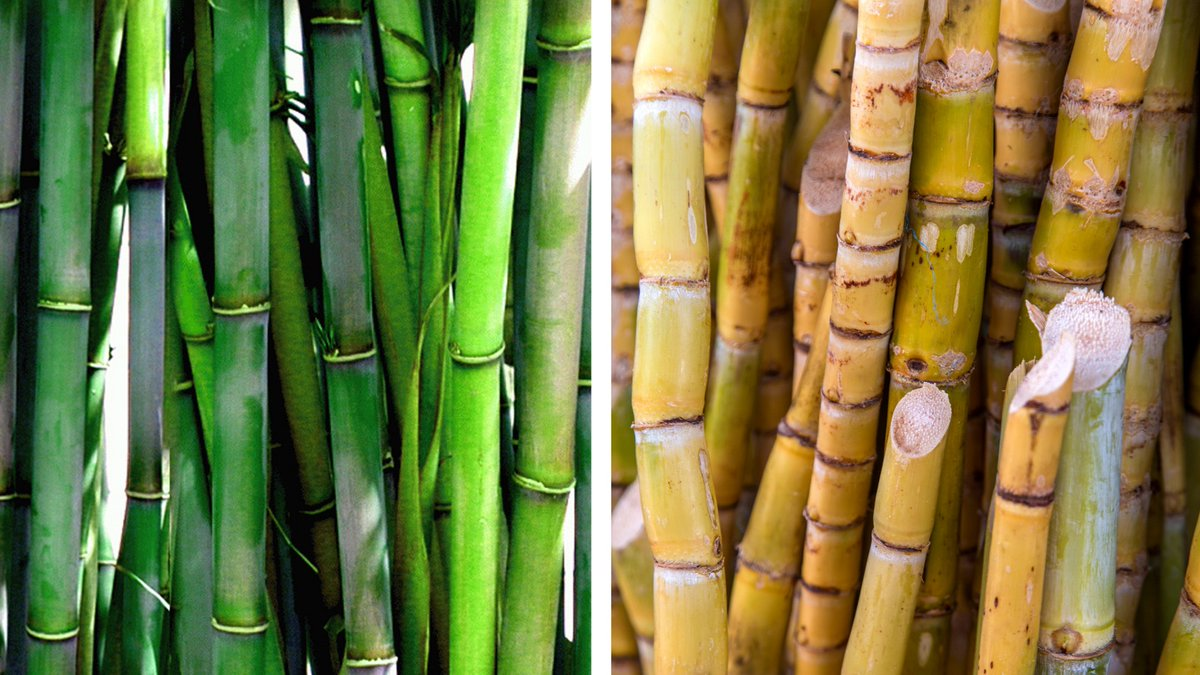
As sustainability becomes a driving force in today’s business world, companies are increasingly turning to eco-friendly disposable tableware. Bamboo and sugarcane pulp are two popular materials in this shift towards greener alternatives. But which one is truly the best for your business?
Bamboo and sugarcane pulp are both viable, eco-friendly alternatives to plastic. This post compares their features, benefits, and drawbacks for sustainable packaging solutions.
Keep reading to explore the differences between bamboo and sugarcane pulp to make the right choice for your eco-conscious business.
Understanding Bamboo and Sugarcane Pulp?

Both bamboo and sugarcane pulp have gained recognition for their sustainability and versatility. But what exactly makes each of them suitable for eco-friendly tableware? Let’s break down their unique characteristics.
Bamboo Pulp
Bamboo pulp is made from the fibers extracted from bamboo. Bamboo, a highly renewable resource, grows rapidly and can be harvested in just 3 to 5 years. The process of turning bamboo into pulp involves soaking the bamboo stalks, extracting fibers, and then processing them into a fine pulp. Bamboo products can also be dyed to different colors, making them highly versatile.
Since bamboo grows quickly and doesn’t require extensive care, it’s an eco-friendly option. However, it does need industrial composting to decompose properly. The process of extracting and processing bamboo is also more expensive than that of other materials, contributing to higher product costs.
Sugarcane Pulp (Bagasse)
Bagasse refers to the fibrous pulp that remains after extracting juice from sugarcane stalks. Traditionally discarded as agricultural waste, bagasse is now being repurposed for many products, including disposable tableware. Like bamboo, sugarcane is a fast-growing plant, with a quick harvest cycle of 12-18 months. It is easily renewable and can be a highly sustainable option when used to make products like plates and cups.
Sugarcane pulp is typically less expensive to process than bamboo pulp, but it requires bleaching chemicals to achieve the desired whiteness. The material is biodegradable and compostable, making it another strong contender for sustainable packaging.
Key Differences Between Bamboo and Sugarcane?
Growth and Sustainability
Bamboo:
Bamboo grows incredibly fast, reaching maturity in just 3-5 years. After harvesting, it regenerates quickly, making it a highly sustainable resource. Bamboo doesn’t require pesticides or fertilizers to grow, making it less harmful to the environment.
Sugarcane:
Sugarcane also grows quickly, with harvest cycles of just 12-18 months. However, large-scale sugarcane farming can lead to soil degradation and water overuse. While sugarcane efficiently uses its byproducts like bagasse, intensive farming practices can affect the ecosystem.
Strength and Durability
Bamboo:
Bamboo is known for its natural strength, making it ideal for sturdy products like cutlery and rigid packaging. Even when wet, bamboo retains its durability, giving it an edge over sugarcane. Its high tensile strength allows it to be used for more demanding applications.
Sugarcane:
Sugarcane pulp, while durable for basic tableware like plates and containers, is not as robust as bamboo. Sugarcane products are generally weaker, and their performance can suffer when exposed to moisture. They are better suited for simple, flat items that don’t require much structural integrity.
Carbon Emission and Absorption
Both bamboo and sugarcane are much more efficient at absorbing carbon dioxide than traditional plastic materials. However, sugarcane, as a C4 plant, absorbs carbon dioxide more efficiently than bamboo, which is a C3 plant. This makes sugarcane slightly better in terms of carbon sequestration.
Biodegradability and Compostability
Sugarcane:
Sugarcane products are highly compostable, making them ideal for businesses aiming for a circular economy. They break down quickly and can be used as compost after disposal, contributing to the health of the soil.
Bamboo:
Bamboo is also biodegradable, but its decomposition process is slower compared to sugarcane. Bamboo products may require industrial composting, making them less suited for at-home composting.
Product Applications and Versatility
Bamboo:
Bamboo can be molded into a variety of products such as cups, plates, cutlery, and takeout containers. It is also used in construction, textiles, and paper. This versatility makes bamboo a go-to option for businesses looking for a wide range of sustainable products.
Sugarcane:
Sugarcane pulp is primarily used in simpler products like plates, bowls, and takeout containers. While it’s versatile, it’s generally limited to flatter items due to its lower strength compared to bamboo. It’s an excellent choice for lightweight disposable packaging.
Cost
Sugarcane:
Bagasse products are generally cheaper than bamboo-based products. The lower production cost makes it an affordable option for businesses that prioritize cost-efficiency over durability.
Bamboo:
Bamboo products, especially high-quality ones, tend to be more expensive. The cost of raw materials, processing, and the sustainable farming practices behind bamboo contribute to the higher price tag.
Water and Chemical Use
Bamboo:
Bamboo requires minimal water to grow and typically doesn’t require harmful chemicals. Its environmental impact is relatively low in terms of chemical processing, especially when compared to traditional plastics.
Sugarcane:
Sugarcane, on the other hand, often needs bleaching chemicals to whiten the pulp. However, it requires less water for processing than many other crops, such as cotton.
Pros and Cons?
Bamboo Pulp
Pros:
- Made from a rapidly renewable resource
- Biodegradable and compostable
- Naturally strong and durable
- Antimicrobial properties
- Versatile in shapes and applications
Cons:
- More expensive than sugarcane pulp
- Requires industrial composting for full decomposition
- Needs additional treatment to resist pests and improve durability
Sugarcane Pulp
Pros:
- Made from sugarcane waste material
- Biodegradable and compostable
- More affordable than bamboo pulp
Cons:
- Weaker and less durable than bamboo
- Requires bleaching chemicals
- Limited to simple, flat shapes
- Intensive farming practices can degrade soil quality
Which is the Better Option?
When it comes to strength, water resistance, and antimicrobial properties, bamboo stands out. It’s perfect for products that need to be durable, such as cutlery and rigid containers. However, if you’re looking for an affordable and simple, single-use solution, sugarcane may be the better choice.
Sugarcane is excellent for lightweight products and utilizing agricultural waste, making it more budget-friendly. On the other hand, bamboo is ideal for premium, long-lasting tableware that requires sturdiness.
If you’re aiming for high-end, durable products, bamboo is the better option. But if you’re looking to produce cost-effective, disposable items, sugarcane might be the ideal solution.
Frequently Asked Questions (FAQs)
1. What is the difference between bamboo and sugarcane pulp for food packaging?
Bamboo pulp is made from the fibers of bamboo plants, which grow quickly and sustainably. Sugarcane pulp is a byproduct of sugarcane processing, mainly derived from the fibrous residue left after juice extraction. Both materials are eco-friendly, biodegradable, and compostable, but bamboo is typically more durable, while sugarcane pulp is more readily available and often used for lightweight products.
2. Which material is more sustainable, bamboo or sugarcane?
Both bamboo and sugarcane pulp are highly sustainable options. Bamboo grows quickly without the need for pesticides or heavy irrigation. Sugarcane pulp is a byproduct of sugar production, making it a renewable resource with a lower environmental impact. The choice depends on factors like product durability and local availability.
3. Are bamboo and sugarcane products biodegradable?
Yes, both bamboo and sugarcane pulp products are biodegradable. They break down naturally over time, making them excellent alternatives to single-use plastic that contributes to landfill waste.
4. Are bamboo and sugarcane products microwave and freezer safe?
Most bamboo and sugarcane pulp products are microwave and freezer safe for short periods. However, it’s always best to follow the manufacturer’s recommendations for specific product use and avoid exposing them to extreme temperatures for prolonged periods.
5. How do bamboo and sugarcane products compare in terms of durability?
Bamboo products tend to be stronger and more durable, making them ideal for heavier food items. Sugarcane products are typically lighter and better suited for foods that are less heavy or require more flexibility, but they still provide adequate durability for most food packaging applications.
6. Are bamboo and sugarcane products compostable?
Yes, both bamboo and sugarcane pulp products are compostable. They can be disposed of in industrial or home composting systems where they will break down into organic matter, reducing their environmental footprint.
7. Can I use bamboo or sugarcane products for hot foods and liquids?
Yes, both materials can handle hot foods and liquids, though it’s important to ensure they are designed for this purpose. Some products may have specific temperature limits, so checking the product details is always recommended.
8. Where can I purchase bamboo and sugarcane packaging products?
You can find bamboo and sugarcane products through various suppliers, including eco-friendly packaging distributors, online marketplaces like Alibaba, and specialty stores focused on sustainable products. At Panabam, we offer a variety of bamboo and sugarcane packaging solutions to suit your needs.
Conclusion
Both bamboo and sugarcane pulp are exceptional, eco-friendly alternatives to traditional plastics. Each material has its own strengths and weaknesses. Depending on your business’s needs—whether it’s durability or affordability—you can make an informed choice. If you’re looking for high-quality, eco-friendly tableware, don’t hesitate to reach out. At PANABAM, we specialize in bamboo pulp products that provide both sustainability and strength for your business.
Find the Perfect Sustainable Packaging for Your Business!
Unsure whether bamboo or sugarcane pulp is the right choice for your packaging needs? Reach out to the Panabam team today, and we’ll help you choose the ideal eco-friendly solution. Let’s make sustainability a key ingredient in your business’s success!

Shmily Lee
Hi there! I’m Shmily, a proud mom to an amazing boy and the manager of PANABAM. We’ve been producing eco-friendly bamboo tableware that’s both sustainable and high-quality. I’m passionate about helping businesses embrace greener solutions. Let’s connect and create a more sustainable future together!